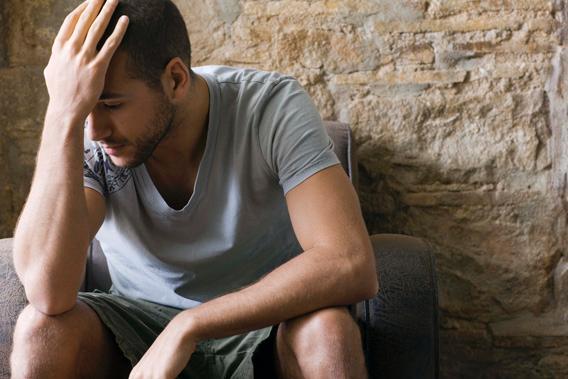Research shows that LGBT people, especially those living in the closet, face disproportionate stresses, including higher risk of anxiety and depression. But a study published this week in Psychosomatic Medicine uncovered something surprising: Heterosexual men had higher levels of depression than gay and bisexual men. Less surprising but still important: Lesbians, gays, and bisexuals who are open about their sexuality had less stress than those who conceal it.
The authors gave several hypotheses to explain the surprising finding that straight men have higher stress than out gay men. Some were limitations to the study. The sample size of 87 was relatively small, and the respondents were drawn via online ads and word of mouth, likely producing a selection bias—gay folks who are most at peace with their sexuality might be more willing to participate than those still struggling. Other hypotheses related to the character-building component of surviving and rejecting years of shame and stigma. Perhaps this struggle produces coping skills that straight men never need to learn.
Or do they? One of the most important—and most maligned—contributions of both the multicultural and LGBT movements of the past decades has been how the attention to minority experiences impacts everyone, not just minorities. African-Americans are not the only ones with a race; women are not the only ones with a gender; immigrants aren’t the only ones who’ve left their homes to forge a new identity; gays aren’t the only ones with a sexual orientation—or a secret to conceal. Understanding that these aspects of identity affect us all is crucial to ensuring that they don’t govern our lives.
The oft-derided “men’s movement” took this approach in its efforts to free men from the burdens imposed on them by unrealistic expectations. Growing out of feminism, the movement acknowledged that men had disproportionate and unjust levels of power but insisted this was not the unalloyed advantage it might appear to be. Men suffered from gender inequality, too, and faced a whole added level of stress born of the internalized belief that they must adhere to certain roles, especially those of breadwinner and protector, which discouraged them from expressing vulnerabilities, fears, and emotional needs.
These burdens have been built into our laws and culture for years. Recall that the rationale for the military’s ban on open gays had nothing to do with the abilities of gay people but was an accommodation to the special needs of straight men. The late sociologist Charles Moskos, who coined “don’t ask, don’t tell,” testified before Congress that because of the “sexual insecurities” of straight men, “this is exactly why we need the ban.” All-male groups have homoerotic tendencies, he explained, creating anxiety around their own unwelcome desires. “Once these homoerotic tendencies are out, the cat is out of the bag, then you have all kinds of negative effects on unit cohesion.” The solution was repression, achieved by coddling straight men.
When the law was repealed in 2011, it was celebrated as an LGBT victory. But it could also be seen as a reflection of new confidence in the modern male and a professionalized, all-volunteer military. The same could be said for last week’s announcement that the Pentagon would lift the ban on women in combat. The argument against women in combat (aside from George Will’s passionate case for upper-body strength) included the claim that women would distract men because of sexual desire. But in reality, resistance to equality was more complex, rooted in the fragile identity of the modern male. As I recently explained, both Moskos and members of the Joint Chiefs of Staff opposed women in combat in the 1990s not because of ability or even distraction but because of their attachment to cultural ideas about gender. Gen. Merrill McPeak acknowledged he would select an unqualified man over a qualified woman even at the cost of military effectiveness, admitting, “It doesn’t make much sense, but that’s the way I feel about it.”
Gay people have been dealing with this kind of “logic” for years. And it has a silver lining. For all the added struggles of being LGBT, the experience of coming out to someone who says, “I love you even so” can create a sense of acceptance and relief that many straight people never get to enjoy. Those who have never come out about anything as traditionally shameful as being queer remain silently burdened by responsibilities, roles, and a level of repression—often self-imposed—that add needless stress to their lives.
The dramatic leaps forward in LGBT equality over the past few years have not only been about legal equality but about replacing shame with dignity. In addition to the right to serve in uniform and marry in several states, gay people have enjoyed a new sense of liberation from needless emotional repression. If this movement is to amount to more than the simple assertion of one group’s right to be like everyone else, it must spread the lessons of liberation. And if straight men are to be free from the hoary notions that cause them their own undue stress, they should take a page from both the women’s and LGBT movements.
In 1993, Gerald Garvey and John DiIulio, then politics professors at Princeton, wrote an article in the New Republic explaining that the reason for the military’s gay ban was that, “by military cultural definition, a soldier can’t be gay and be a part of all that is best or most cherished in military life and lore.” The same was true of women. Now it’s true of neither. Yet for straight men, the stresses of performing manhood persist. The authors of the study say their findings confirm the importance of disclosure. Hopefully straight men can recognize that they, too, inhabit a closet of sorts, from which they can liberate themselves.
